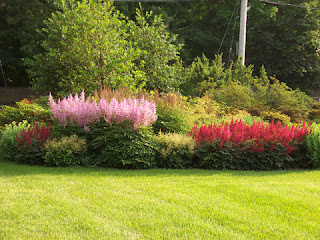The astilbe flower is thought to be one of the easiest perennials to grow and care for. Although they may be feathery and delicate in appearance, they are hardy plants that develop few diseases, attract very few pests and can survive in a variety of landscapes.
The astilbe flower is native to areas of China and Japan, but during the early 20th century, famous German botanist George Arends introduced this plant to the United States. One of George Arends’ best known hybrid groups is the Astilbe Arendsii Group, which is a combination of A. astilboides, thunbergii, chinensis, japonica, and can mostly be seen in creamy white and deep burgundy hues.
Despite the fact that they can be grown practically anywhere, they are best suited to areas with moderate to full shade, and moist – but not drenched – soil. Astilbes come from a small genus of the saxifragaceae family, with only 18 species within in its group. Their foliage is similar in appearance to ferns, and their flowers come in mild, pretty shades of white, pink, maroon and lavender.
Given the fact that the astilbe flower is both lovely to look at and easy to care for they are often given as gifts. Unlike most flowers, the symbolism of astilbe is not exactly prevalent. However, many believe that they are a symbol of patience and dedication to a loved one.
When presented to a beloved that will be away for a long period of time, they express the idea that you will wait for them. However, these flowers do not require any specific meaning to be given as gifts. They look beautiful in any bouquet, as potted plants, or even in dried arrangements.
The astilbe flower is native to areas of China and Japan, but during the early 20th century, famous German botanist George Arends introduced this plant to the United States. One of George Arends’ best known hybrid groups is the Astilbe Arendsii Group, which is a combination of A. astilboides, thunbergii, chinensis, japonica, and can mostly be seen in creamy white and deep burgundy hues.
Despite the fact that they can be grown practically anywhere, they are best suited to areas with moderate to full shade, and moist – but not drenched – soil. Astilbes come from a small genus of the saxifragaceae family, with only 18 species within in its group. Their foliage is similar in appearance to ferns, and their flowers come in mild, pretty shades of white, pink, maroon and lavender.
Given the fact that the astilbe flower is both lovely to look at and easy to care for they are often given as gifts. Unlike most flowers, the symbolism of astilbe is not exactly prevalent. However, many believe that they are a symbol of patience and dedication to a loved one.
When presented to a beloved that will be away for a long period of time, they express the idea that you will wait for them. However, these flowers do not require any specific meaning to be given as gifts. They look beautiful in any bouquet, as potted plants, or even in dried arrangements.

.jpg)
.jpg)
.jpg)
.jpg)